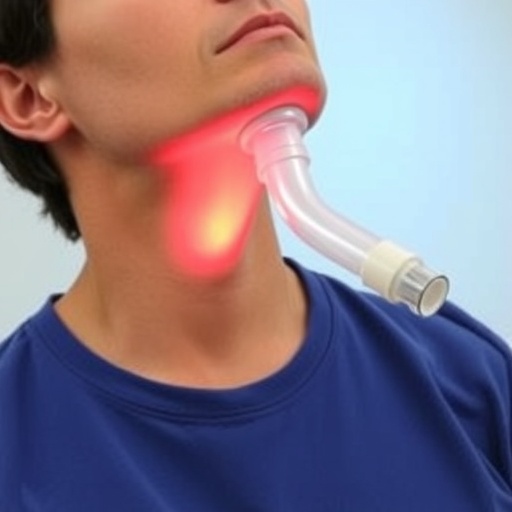In the rapidly evolving field of neonatal resuscitation, the quest for the most effective airway management tools remains paramount. Recent investigations have brought the use of supraglottic airways (SGAs) into sharp focus, particularly concerning their functionality not merely as conduits for medication administration but as superior instruments for optimized aeration in newborns requiring urgent respiratory support. The seminal work by C.T. Roberts, published in Pediatric Research in 2025, challenges conventional paradigms and emphasizes the nuanced role of SGAs during neonatal resuscitation, underscoring their potential beyond traditional expectations.
Neonatal resuscitation, a critical procedure performed in the fragile minutes after birth, demands swift and precise intervention to ensure adequate oxygenation of the infant’s tissues. Historically, endotracheal intubation has been regarded as the gold standard for airway management, especially in scenarios where positive pressure ventilation is insufficient or when medications need to be delivered directly into the lungs. However, this approach requires significant skill and can be time-consuming, potentially delaying effective ventilation in urgent circumstances.
Understanding the physiology behind this is key. Neonatal lungs and airways differ considerably from those of older children and adults, featuring greater compliance and smaller anatomical structures. Consequently, effective lung aeration hinges on achieving the delicate balance of optimal airway pressure and volume without causing barotrauma or volutrauma. Roberts’ analysis highlights that SGAs enable consistent delivery of positive pressure ventilation, optimizing alveolar recruitment and gas exchange while minimizing airway trauma.
Another significant aspect raised by Roberts pertains to the training implications for neonatal care providers. The expertise required for endotracheal intubation is substantial, often necessitating extensive practice to achieve proficiency, which is not always feasible across all delivery settings, especially those with limited neonatal intensive care resources. The expedited insertion process and relatively lower skill threshold associated with SGA placement could democratize high-quality airway management, reducing delays and improving outcomes on a broader scale.
The study also contemplates the real-world impact of adopting SGAs as frontline airway devices during neonatal resuscitation. Given that timely and adequate lung aeration is the cornerstone of immediate survival and long-term neurological outcomes, Roberts argues that integrating SGAs more consistently within resuscitation protocols could translate into statistically and clinically significant improvements in mortality and morbidity. Notably, the research emphasizes that medication delivery should be ideally pursued through alternative routes—such as intravenous or intraosseous administration—rather than relying heavily on airway-based drug instillation when SGAs are employed.
Roberts’ meticulous research methodology involved comparing neonatal ventilation parameters across various airway devices, utilizing both sophisticated manikin simulations and controlled clinical observations. The data convincingly reveal enhanced tidal volume delivery and decreased airway leak fractions with the use of SGAs, leading to more stable oxygen saturation trajectories during initial resuscitation phases. This technical edge could redefine how early respiratory support is conceptualized, especially in infants facing perinatal asphyxia or other causes of respiratory failure.
Another pivotal contribution of the study lies in its exploration of the mechanical properties of SGAs tailored for neonates. Traditional adult-sized SGAs are ill-suited for newborns due to anatomical differences, but neonatal-specific designs encompass innovative features such as ultra-soft cuff materials and anatomically contoured shapes that reduce trauma risk and improve seal integrity. Roberts highlights these design nuances as critical enablers of the superior aeration performance documented.
In addition to the physiological and procedural dimensions, the study captures the psychological and systemic benefits arising from SGA adoption. Healthcare providers report reduced procedural anxiety and increased confidence when using SGAs, factors that can positively influence team dynamics and promptness of intervention. These human factors, though often underappreciated, play a vital role in optimizing neonatal resuscitation outcomes.
While the potential of SGAs shines in Roberts’ work, the article judiciously acknowledges limitations and future research directions. Notably, long-term follow-up studies are essential to conclusively determine whether enhanced early aeration conferred by SGAs correlates with improved neurodevelopmental trajectories. Further, integrating SGAs with emerging technologies such as real-time ventilation monitoring and feedback systems could push the frontier of neonatal airway management even further.
Roberts’ findings challenge neonatal care teams and policy-makers to reconsider existing airway management algorithms, advocating for broader education and practice shifts that prioritize lung aeration efficiency over traditional medication administration routes when using SGAs. This reorientation could ultimately lead to a paradigm where airway management in newborn resuscitation is more accessible, effective, and aligned with neonatal physiological principles.
In sum, the investigation into supraglottic airway usage during neonatal resuscitation posits a compelling argument: SGAs, while less suited for precise medication delivery, excel as tools for achieving optimal lung aeration. This not only streamlines emergency care but could fundamentally alter clinical outcomes for the most vulnerable patients. Roberts’ pioneering work thus heralds a new chapter in neonatal resuscitation science—one that harmonizes device innovation with intricacies of neonatal respiratory physiology to save lives from their very first breaths.
Subject of Research: Supraglottic airway use during neonatal resuscitation and its efficacy for aeration versus medication administration.
Article Title: Supraglottic airway use during neonatal resuscitation: better suited to aeration than medication?
Article References:
Roberts, C.T. Supraglottic airway use during neonatal resuscitation: better suited to aeration than medication?. Pediatr Res (2025). https://doi.org/10.1038/s41390-025-04106-w
Image Credits: AI Generated
Tags: advantages of supraglottic airwaysairway management tools in neonatologyC.T. Roberts researcheffective ventilation strategies for newbornsendotracheal intubation alternativesneonatal emergency interventionsneonatal resuscitation techniquesnewborn respiratory supportoptimizing infant aeration methodspediatric respiratory care practicesrapid airway establishment in infantssupraglottic airway management




